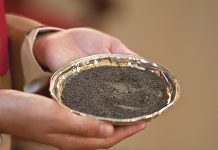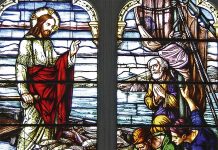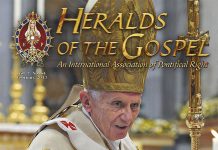The long pontificate of Blessed Pius IX was filled with episodes that highlight his goodness as pastor and father. To ignore this facet of his life would create a distorted vision of his true spiritual profile.
The Eternal City rejoices. A multitude coming from numerous nations throngs to St. Peter’s Square to watch the procession, which sets out punctually. Two hundred bishops, ranked in two rows in order of seniority, precede the College of Cardinals. Vested with mitre and cope, the Successors of the Apostles compose the court of the Vicar of Christ, who crowns the procession garbed in the splendour of the papal regalia.
The choir intones the Litany of the Saints, as if inviting the Church Triumphant to participate in the tribute that the Church Militant will pay to the Queen of Heaven and Earth, of Angels and of Men. The Pope takes his place and Holy Mass begins.
After the chanting of the Gospel in Greek and Latin, the Cardinal Dean, accompanied by a prelate from each rite, approaches the pontifical throne to express the supplications of the entire Church, asking the Holy Father to declare that Mary was conceived without original sin. The Pope joyfully welcomes the request and invokes the Holy Spirit. Everyone kneels and raises their hearts to Heaven in one voice, chanting the Veni Creator Spiritus.
Thus begins the solemn reading of the Bull Ineffabilis Deus: “We declare, pronounce, and define that the doctrine which holds that the most Blessed Virgin Mary, in the first instance of her conception, by a singular grace and privilege granted by Almighty God, in view of the merits of Jesus Christ, the Saviour of the human race, was preserved free from all stain of original sin, is a doctrine revealed by God and therefore to be believed firmly and constantly by all the faithful.” 1 The regiment of Castelo de Sant’Angelo acclaims the new dogma with a canon salute as the bells of Rome peal out announcing the glorification of the Immaculate Virgin.
Now, the very same man presiding over this solemn ceremony was also accustomed to walking through the Eternal City “surrounded by a crowd of indigents and unfortunates, consoling them with words and alms; or by a group of children to whom he addressed questions of doctrine, and whose exuberant joy was proof of the paternal affection with which he spoke to them.” 2

Faithful to his ministry in every circumstance
Such was Pius IX, the Pope who marked Church history with the Dogma of the Immaculate Conception; the zealous guardian of orthodoxy, author of the Syllabus and the Encyclical Quanta Cura; he convoked Vatican Council I and declared Pontifical Infallibility. His pontificate spanned almost the entire nineteenth century, obliging him to heroically and courageously confront the intricate problems of his time, undermined by materialists and revolutionaries of diverse stripes.
Upon inscribing him in the roll of the blessed, John Paul II affirmed: “Amid the turbulent events of his time, he was an example of unconditional fidelity to the immutable deposit of revealed truths. Faithful to the duties of his ministry in every circumstance, he always knew how to give absolute primacy to God and to spiritual values. His lengthy pontificate was not at all easy and he had much to suffer in fulfilling his mission of service to the Gospel. He was much loved, but also hated and slandered.” 3
Nevertheless, the long and fruitful life of the Blessed is decked with beautiful fioretti in which his goodness as pastor and father shines forth, amid his battles in favour of the Church. These vignettes, frequently ignored by historians are, however, essential in grasping the true vision of his spiritual profile. Let us peruse a few of them, insofar as the limited space of an article permits.
Childhood marked by the notion of a prisoner-Pope
Giovanni Maria was born in Senigallia, one of the oldest cities of the Italian Peninsula, on May 13, 1792, during the tumultuous era of the French Revolution. He was the second child of Count Jerome Mastai-Ferretti and Catherine Sollazzi, of equal nobility.
He was still very young when Napoleon’s troops invaded Italy and carried off Pius VI, 81 years of age, as a prisoner. The Countess always prayed with the family for the suffering Pope, and little Giovanni Maria, despite his tender yeas, began taking an interest in the frequent reports of the august prisoner and of the calamities befalling the Church in this age of impiety and anticlericalism.
Unable to grasp why God, as Lord of the universe, permitted His Vicar on earth to be treated as a criminal, he asked his mother who piously responded:
“My son, it is because God allows him to be treated just like Christ.”
Pius VI died in exile, and in learning of the problems impeding the conclave, the boy asked the Countess:
“Mama, is it true that we no longer have a Pope?”
“Calm yourself, my child, kings can die and not be replaced. However, the Popes will never end! Be confident, God will provide. 4”
Giovanni Maria never forgot this reply.

Consecrated to Our Lady from the cradle
At age 12, he entered Valterra College in Tuscany, under the direction of the Piarists where a leaning for the ecclesiastical state blossomed, despite the cruel trials the Church was undergoing, or perhaps because of them. Nevertheless, some years later, a serious illness—epilepsy—seized the young man, and he was declared incurable by doctors, who also forecasted an early death.
Now, the Countess Mastai-Ferretti, in addition to giving her son the name of the Beloved Disciple and of the Blessed Virgin had consecrated him to the Virgin from the cradle: “O my Mother, just as you adopted the disciple, adopt him also. I consecrate and give him to you.” 5 As we will see, Mary gladly accepted the bestowal of this fervent mother.
The physicians’ prognosis did not undermine his vocation. The young man left for Rome and began a course of theology. Some time later, having received minor orders, he returned to Senigallia together with Prince Odescalchi, prefect of the pontifical court, who went there on mission. Msgr. Vincent Strambi, today a canonized saint, also accompanied them, along with other priests.
That mission, during which he served as catechist, marked the beginning of his evangelization efforts. Far from compromising his health, the missionary activities proved beneficial—upon returning to Rome, Prince Odescalchi obtained the necessary authorization for Giovanni Maria to be ordained deacon in December of 1818.
He made a pilgrimage to the Holy House of Loreto to beseech Our Lady for a complete and immediate cure, and from that moment the attacks ceased. Shortly afterwards, Pope Pius VII granted him permission to conclude his philosophical and theological studies in the Roman College. In April of 1819, he received priestly ordination, with the condition of always celebrating the Holy Sacrifice assisted by another priest.
However, after some months had elapsed, he dared ask the Pope to be dispensed from this inconvenience, confiding in the grace received in Loreto. In response, the Holy Father predicted: “Yes, we wish to grant you this favour, especially considering that it seems to me that from now on you will no longer be tormented by this cruel infirmity.” 6
In fact, the illness completely disappeared, leading him to declare that he owed “the grace of his vocation to the priesthood and the necessary health to ascend to such a sublime dignity” 7 to the Virgin Mary.
A white dove alights on a carriage
After ordination, Father Mastai-Ferretti’s first duty was the administration of the Tata Giovanni Institute, where he not only instructed and formed the one hundred orphans sheltered there, but also supported them with his own resources. In 1820, he was designated to accompany Archbishop Giovanni Muzi, appointed Apostolic Nuncio to Chile, and the separation from those children was painful: they “clung to his vestments, and those who could not get near to him begged him not to abandon them.” 8
In the exercise of his new role, he travelled not only through Chile, but also Argentina, Bolivia, Peru, Colombia and Uruguay, and gained a deep understanding of the state of the Church in those lands. Upon returning to Rome in 1825, he received the duty of overseeing the St. Michael Hospice.
At just 35 years of age he was appointed Archbishop of Spoleto, and some years later, Gregory XVI transferred him to the Diocese of Imola, which according to prevailing custom, implied his desire to soon create him Cardinal. In both places he left his mark as a zealous pastor and brought innumerable benefits to his flock.
Consequently, on December 14, 1840, Archbishop Giovanni Maria received the cardinal’s biretta from the Pope, together with the title of Cardinal Priest of Sts. Marcellinus and Peter. And in 1846, with the death of Gregory XVI, he set out for the Eternal City to participate in the conclave.
During this trip a singular episode unfolded. While crossing Fossombrone, in the Province of Marca, the carriage bearing Cardinal Mastai stopped for a moment and a large crowd gathered, eager to glimpse a Prince of the Church. Suddenly, a white dove appeared—no one knew where it had come from—and alighted on the roof of the carriage. The people took this as a good omen and began to applaud and shout: “Viva! Viva!” The small bird was not the least frightened, calmly remaining on its perch even when threatened with a broom. The acclamations of the crowd resounded prophetically: “Viva! Viva! This is the Pope!” 9
The people of Fossombrone were right. On June 16, 1846, the Sacred College elevated him to the Pontifical Throne.
Pius IX began his reign by granting amnesty to the instigators of political crimes, an act of generosity that garnered him a wave of approval, coming even from enemies of the papacy. Nevertheless, the son of the countess, who had prayed so ardently for Pius VI, had no illusions. He knew that after the Hosanas it would not be long before the Crucifige would resound, uttered by the same lips that had applauded him on that occasion. “Alas,” he exclaimed on one occasion, “I know all too well that Palm Sunday will be followed by Holy Week!” 10
Three hours each day in adoration
As with all saintly souls, Pius IX was a man with a continuous and deep interior life. “The Holy Father spent three hours each day kneeling in adoration before the Blessed Sacrament. It was there that he drew the inspiration and strength needed to direct the Church,” 11 affirms a biographer.
Soon after daybreak, the Pope would celebrate Holy Mass in his private chapel, where he himself filled the votive lamp that perpetually burned before the tabernacle. His Mass was long; at times tears would flow down his face as he held in his consecrated hands the Body, Soul and Divinity of Him of whom he was Vicar.
When forced to flee to Gaeta, in the Kingdom of Naples, after imprisonment in the Quirinal Palace, he carried around his neck a small pyx with the Blessed Sacrament, the same used by Pius VI when he was taken to Valence in Rhone, France.
Pius IX fostered special devotion not only to Jesus and Mary, but also to her most chaste spouse, St. Joseph. His filial love for the foster father of Jesus prompted him to establish his feast as Patron of the Universal Church.

Father who inspires confidence
But perhaps one of the richest facets of this Pope’s personality that merits mention with these brief lines, is the total confidence the faithful placed in him, as in a true father.
One day, an inhabitant of Monti, a neighbourhood bordering the Pontifical residence, lost his horse that hauled the wares he sold at the market to support his family. Aware of the generosity of the Holy Father, he went to the palace to ask the Pontiff if he would donate a horse he had little use of, from his stables.
Pius IX received the request with all kindness and was even pleased by it, granting him not only what he had asked, but also two gold pieces. “This man cannot be rich,” the Pontiff reasoned, “for if that were so, would he come looking for a horse on the Quirinal?” 12
Another display of paternal affection occurred with a Swiss soldier from Lucerne, a volunteer in the pontifical army, who was seriously wounded after courageously fighting in Castelfidardo. Since he was not Catholic, the Pope’s enemies allowed him free passage to Rome, where he arrived in a pitiful state. Learning of the poor soldier’s desire to speak with him, Pius IX went to visit him personally and, at his beside, heard from the lips of the brave man these moving words: “I am sure that I am going to die, Holy Father, but I will die happy because you are at my side. And does not dying for the Catholic Church mean that I will not die as a member of any other religion?” 13 The Pope embraced him, blessed him and welcomed him into the bosom of the Church. He gave him the last Sacraments and a few hours later the soldier passed away.
It was as pastor and father that the Vicar of Christ ended his days, on February 7, 1878. His final pontifical act, from his deathbed as he prepared to surrender his soul to his Creator, was a final blessing for the College of Cardinals and for the entire Catholic world, given with a wooden cross which he always carried with him, and in which was encrusted a fragment of the True Cross. 14
Perhaps he recalled at that moment the words of his dearly beloved mother, which had so marked his childhood: “Kings can die without being replaced. However, the Popes will only finish with the end of the world!” He died with an unshakeable faith in the promise of Our Lord—“You are Peter, and upon this rock I will build my Church, and the gates of hell shall not prevail against it” (Mt 16:18)—imbued with the certainty that revolutions come and go, and though impetuous winds may toss the Barque of Peter, it will always arrive safely at port. ◊
Notes
1 PIUS IX. Bula Ineffabilis Deus, n.41.
2 VILLEFRANCHE, Jacques Melchior. Pio IX. São Paulo: Panorama, 1948, p.391-392.
3 JOHN PAUL II. Homily for the Rite of Solemn Beatification of Five Servants of God, 3/9/2000, n.2.
4 Cf. VILLEFRANCHE, op. cit. p.2-4.
5 HUGUET, SM. O espírito de Pio IX. Rio de Janeiro: B. L. Garnier, 1875, p.18.
6 VEUILLOT, Louis, apud HUGUET, op. cit., p.62.
7 HUGUET, op. cit., p.23.
8 VILLEFRANCHE, op. cit., p.10.
9 Idem, p.19.
10 Idem, p.52.
11 HUGUET, op. cit., p.5.
12 VILLEFRANCHE, op. cit., p.35.
13 Idem, p.252.
14 Cf. SODERINI, Eduardo. Il Pontificato di Leone XIII. Milão: A. Mondadori, 1932, v.I, p.8.





